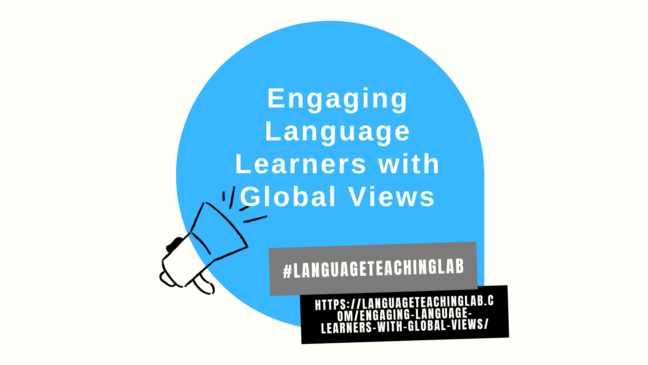Presenting global views connects language students to the experiences of others. It engages their minds, hearts, and hands. There are wonderful resources that help language students broaden their perspective of the world, not necessarily limited to the people in the countries that speak the language they are learning. Why wait until they are at an intermediate level? You may start with novice learners. It all depends on what you show them and what you do with it, i.e. how you use the resource, as well as why you are using that specific resource.
Why global views?
I part with the idea that we live in one world and the more that we learn from each other, the better. As a Spanish teacher myself, I moved from showing only things related to the Spanish-speaking world to showing my students the whole world. Of course, a big part of what we do in class is related to the Spanish world, but I intersect resources that go beyond that. Learning about others helps break down stereotypes, expands our worldviews, and helps us become aware of our interconnectedness and common humanity. In sum, it is about helping my students become globally competent.
How do we use photographs as global views ?
To successfully reach the minds, hearts, and hands of language learners, it is necessary to think through how we introduce, develop, and conclude each lesson. It is also important to think about what background knowledge students need in order to understand the topic and what prior knowledge they bring to class. Using resources thoughtfully is key.
Many times I choose to use photographs to do this type of work because they are potent visuals. They tell stories and we can all relate to stories. Photographers have a unique eye as their lens captures a precious moment in time. It is up to us to show these global views and choose how to do it.
The following are some ways in which I have presented global views to my students.
When I taught elementary school, my students particularly enjoyed when I showed them photographs of classrooms around the world and they had to compare and contrast those with their own classroom. As an added benefit, I learned about students’ prior experiences and their families’ history.
My students love when they can choose. When presenting them with several photographs, I let them choose one that talks to them and ask them to do different activities, from simply describing the photograph to creating a story to only asking and answering questions. Other times, I present them with two photographs and we compare them to find similarities and differences. These types of activities propel great conversations.
The National Portrait Gallery has many classroom resources to use when describing portraiture, and some of them can be applied to analyzing photographs successfully. I especially enjoy:
–Compare and Contrast: Top Hat
There is no doubt that using the Project Zero Thinking Routines makes perfect sense when analyzing photographs. For this type of work, I would go with the Global Thinking Routines ones.
The Library of Congress has a special tool when it comes to analyze photographs that differs from the tools used to analyze other media. It is a wonderful way to start a conversation about photographs. Check it out!
The LOC also has an online analysis tool for students to download and work directly there.
You may also want to read our blog “Authentic Resources with the Smithsonian Learning Lab,” where we give examples of integrating art into the curriculum.
There are so many ways to go when it comes to introducing global views to students. Of course, the images per se are key in making it a powerful experience.
What resources can we use to engage learners with global views ?
The following are some resources based on photographs. Some of these photographs include the topics of school, food, identity, and landscapes and I have used some of them with my novice students. What is important is to choose what to show and how to present it to students.
As an Amazon Associate LTL earns from qualified purchases.
Food
–Article on Menzel’s work in Spanish
–What I Eat (Menzel)
Galimberti’s work on what children play with
Esther Honig’s photos on beauty
–Article on Honig’s photos in Spanish
-Article on Honig’s photos in Spanish
School
–Schools around the world – The Guardian
–Schools around the world – Boston
House
Landscapes, Ecology, Social issues
–Overdevelopment, Overpopulation, Overshoot (OVER)
Each time I present global views to students, their engagement is palpable as global views engage language learners’ minds, hearts, and hands. If you haven’t already, give it a try and let me know how it goes in your classes.
